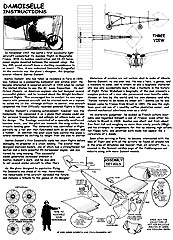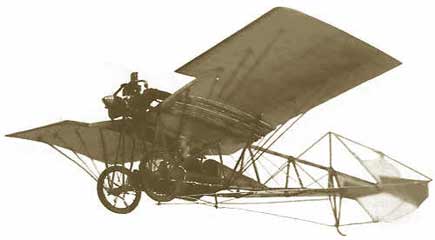Santos-Dumont's Demoiselle Flying Machine
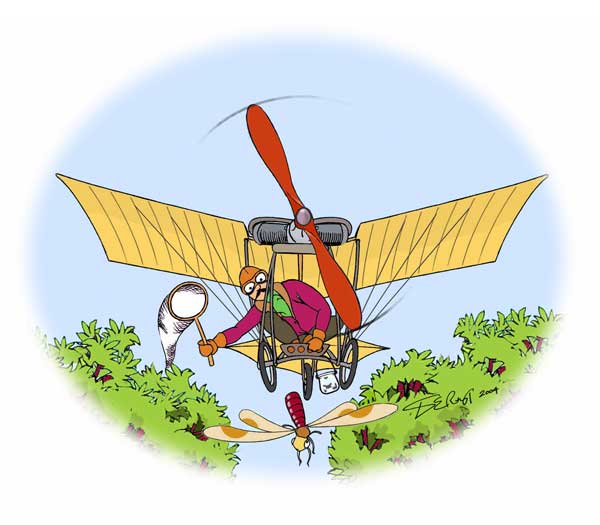
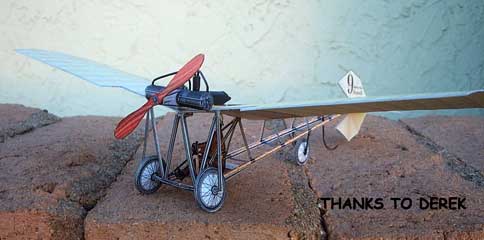
The first was Santos-Dumont's Demoiselle which was a high wing monoplane with a 20 hp horizontally opposed Dutheil-Chalmers engine mounted above the wing. A single bamboo pole supported tail surfaces, which pivoted on a universal joint to act as both elevator and rudder. There was an auxiliary rudder either side of the pilot and an auxiliary elevator between the front wheels. There appears to have been no control in roll. In the 24 hp Antoinette engine was mounted between the wheels and linked to the propeller by a drive chain.
In 1909 he exhibited the first version of his No. 20 "Demoiselle" Bamboo, wood and linen were the main components of what was at
that time, the smallest and lightest aircraft in the world. "Le
Petit," as the Parisians called the Brazilian, intended his creation
to be a kind of "Everyman's Plane," available for the modest sum
of 7,500 francs. It was ultimately placed on the market but was
overshadowed by faster aircraft made by manufacturers who proved
to be keener businessmen. Santos-Dumont was far more distressed,
however, that he had not been the first man to fly-he was three
years too late.
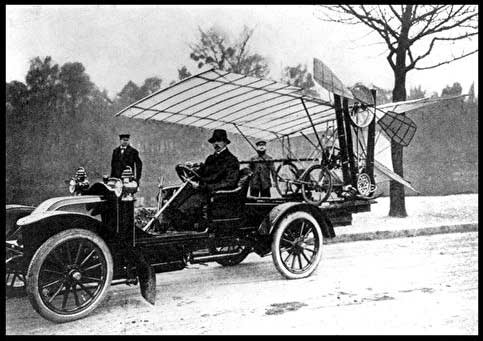 Modeln'pal and chief researcher, Brad Horton, tells us that Santos also was the first to invent the flying car shown here configured to take-off in a ferocious cross wind.. |
Well. . . ., Christmas came early again this year. The weather in the Valley of the Sun must agree with Derek. This one is just begging for the "mixed media" treatment. Thanks again.ymp, john 12/21/04
Thank you very much for this beautiful model. Nuno Rubim, Portugal, 2/23/04
Thanks for the updates: really neat stuff. George Stahlberg
Thank you, thank you, thank you!!! Great to see the Demoiselle. When I saw the version in "Those magnificent men" as a kid, it's what launched me into the world of aviation. Thanks again, Dan
Thank you very much for the Demoiselle. As soon as I assemble it I'll send a picture of it to you (and a picture of myself). Here in Brasil , Santos Dumont is in fact considered ' the father of aviation', and few people know that he ' invented the wrist watch, so
he could handle all those balloons controls without having to fiddle with a pocket watch ! Regards, Marcelo Kraiser
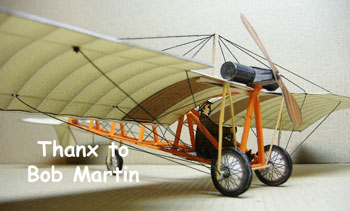
Those magnificent men in their flying machines, is available on dvd. Among the reproduction planes is a Demoiselle.They found that the pilots had trouble getting it off the ground.Then they realized that santos-dumont was such a petite person, no "normal" sized person could fly it. They settled on a woman to pilot the plane, and she is the pilot seen in the movie, doubling as the French pilot.
There is a book about the planes written by the person (anex-raf officer) charged by the movie studio to provide the planes(they built 3 of each of the planes used in the movie). The Shuttleworth Museum in england bought some of the planes for there collection(they have a web site), and the Bristol box-kite (which stood in for a curtiss) recently had its fabric replaced. I sent a photocopy of the book to you, but it was about the time you changed addresses, and it may not have been forwarded to the new address. Thanks for the updates: really neat stuff.
"Many and great are the aeronautical achievements of Mankind in this century; little less than 68 years after Santos-Dumont flew around the Eiffel tower, the U.S. astronaut Neil Armstrong walked on the Moon, on 20 July 1969 -- exactly on the 96th anniversary of Santos-Dumont's birthday. A strange coincidence, which makes us admire even more the achievements of that Brazilian,truly Father of the Aviation."
FYI: Demoiselle is often misspelled as Demoiselle , demoselle, demosel
Alberto Santos-Dumont's Demoiselle
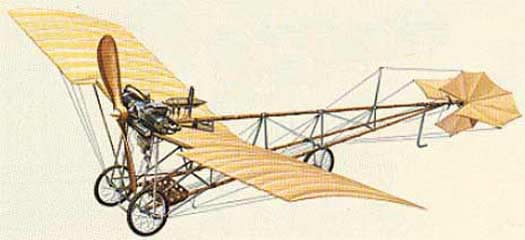

In November 1907 the world's first successful light
aircraft completed its maiden flight in Bagatelle, France. With
its bamboo construction and 18-20 horsepower engine mounted between
the upswept wings, the tiny 235-pound aircraft bore a startling
resemblance to an insect. Thus, it was nicknamed Demoiselle
(Dragonfly). At the controls was the plane's designer,
the daring Brazilian aviator Alberto Santos-Dumont.
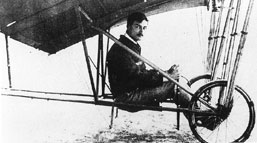 Santos-Dumont, who had taken up residence in Paris in 1898,
was famous as a pioneering balloonist and airship pilot. He became
interested in powered aircraft in 1904 when he visited the United
States to see the St. Louis Exposition. He met Octave Chanute,
an American engineer who had designed several successful gliders,
and he learned about the Wright brothers' powered flights. This
encouraged him to conduct his own experiments with powered aircraft
and he started work on a biplane he called the 14-bis. Although
difficult to control, this aircraft completed the first Officially
recorded powered flights in Europe.
Santos-Dumont, who had taken up residence in Paris in 1898,
was famous as a pioneering balloonist and airship pilot. He became
interested in powered aircraft in 1904 when he visited the United
States to see the St. Louis Exposition. He met Octave Chanute,
an American engineer who had designed several successful gliders,
and he learned about the Wright brothers' powered flights. This
encouraged him to conduct his own experiments with powered aircraft
and he started work on a biplane he called the 14-bis. Although
difficult to control, this aircraft completed the first Officially
recorded powered flights in Europe.
Santos-Dumont's crowning achievement, However, was the Demoiselle. He conceived it as a plane that anyone could use for personal transportation and willingly let others make use of his design. The fuselage consisted of a specially reinforced bamboo boom, and the pilot sat beneath the wing within the tricycle landing gear. The demoiselle was controlled in flight partially by a tail unit that functioned both as an elevator and a rudder. In addition, another elevator was installed in front of the aircraft, and the pilot could help control the plane's lateral movement by shifting his weight from one side to another.
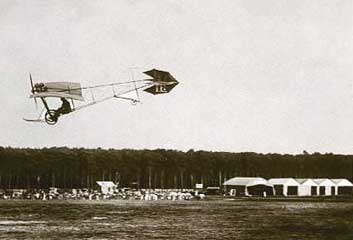
Santos-Dumont's first Demoiselle made two short flights before damaging its propeller in a crash landing. The aviator then designed improved models, one of which had a strengthened tail section and a more powerful 35-horsepower tail engine, and was turned by wing warping. This successful model generated increased interest in Santos-Dumont's work, and he was able to sell several similar aircraft to other fliers.
As the plane designed to popularize flying, the Demoiselle was ahead of its time. Nevertheless the remarkable little aircraft heralded the future and remains a tribute to the genius of its designer.
Historians of aviation are not certain what to make of Alberto Santos-Dumont; no one ever was. He was a hero, a genius, and a visionary to some, and to others he was a laughable character who was only accidentally more than a footnote in the history of flight. Peter Wykeham's biography of the man presents a complex picture of a man who persevered over terrific odds- thrown at him by the world and his own demons-and who "forced history to be made by sheer will." Santos (as he was known) came to France from Brazil in 1891. He was the eighteen-year- old son of a wealthy coffee plantation owner, and showed mechanical adroitness even as a child.
An inveterate gadgeteer, he soaked up French culture insatiably and regarded himself a son of France, even after his return to Brazil in 1928. Santos was short and frail-about five feet tall and weighing no more than ninety pounds -and his attempts to compensate for this by wearing high collars, tall floppy hats, and pinstripe suits made him appear like a caricature of a dandy.
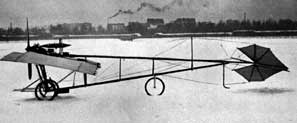 Soon after arriving in Paris, he became intoxicated with the
idea of flight and with all the activity he found all around him
in the area of dirigibles and heavier-than-air aircraft. Santos
made his first flight in Paris in a dirigible of his own design
in 1898, and though he crashed Parisians learned something about
Santos that would be true of him his entire life: crashing never
deterred Alberto Santos-Dumont. He parked his aircraft near his
Champs Elysees apartment and was frequently seen gliding
around Paris to the delight of children, visitors, and the press.
Soon after arriving in Paris, he became intoxicated with the
idea of flight and with all the activity he found all around him
in the area of dirigibles and heavier-than-air aircraft. Santos
made his first flight in Paris in a dirigible of his own design
in 1898, and though he crashed Parisians learned something about
Santos that would be true of him his entire life: crashing never
deterred Alberto Santos-Dumont. He parked his aircraft near his
Champs Elysees apartment and was frequently seen gliding
around Paris to the delight of children, visitors, and the press.
Officialdom looked at these exploits with nervous amusement, particularly
when his dirigibles would occasionally appear at an official function
uninvited and unannounced. When, in 1900, the financier Henri
Deutsch offered a prize of 100,000 francs to the first aeronaut
to fly the seven miles (11km) from the Aéro Club de France's
headquarters in Saint-Cloud to the Eiffel Tower the Paris press
felt that the two leading contenders were Count Ferdinand Graf
von Zeppelin and their adopted son Santos. Santos made two attempts
that ended in spectacular crashes-one on the estate of Baron Rothschild,
the other in the courtyard of the Trocadero Hotel, both in full
view of onlookers and in both cases with Santos barely escaping
with his life-and then, on October 19, 1900, he completed the
course, adding a flourish by circling the Eiffel Tower and returning
to Saint-Cloud.
This extra maneuver almost cost him the prize because the judges claimed that the contest required that the flight be considered over by the securing of the guide rope (to differentiate the flight from an un-powered balloon flight). Popular sentiment was so behind Santos, however, that the judges relented and awarded him the prize. With typical magnanimity, Santos announced that he would give seventy-five thousand francs to charity and to volunteers who had helped him (though Brazil, eager to reclaim its native son, matched the French prize with one of its own).
In 1904, Santos experimented with gliders and helicopters, producing a machine of silk and bamboo. It did not fly, though it tossed Santos about. He went back to the drawing board and emerged in 1906 with a machine that looked like several box kites haphazardly put together. He called it the 14-bis (14-encore) because it was to be carried aloft by his No. 14 dirigible. On July 23, 1906, in a procession that looked like a major parade and included Ernest Archdeacon and other members of the Aéro Club, Santos brought his No. 14 and the 14-bis to the Bagatelle for testing. Noticing that the aircraft had been damaged during the procession, the unflappable Santos announced that the test was off and sent everyone home. He tried again on July 29, this time using a donkey (named Kuigno) to pull the aircraft- dirigible combination.
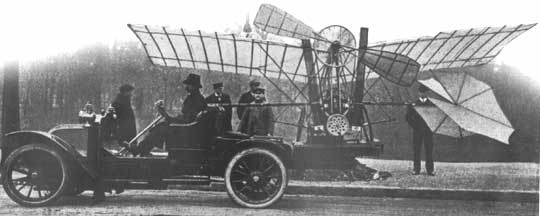
14-bis, the plane in which Santos-Dumont
made his historic 1907 flight.
Santos continued to test the aircraft, soon coming to the conclusion that the dirigible was not necessary. On September 13, the 14-bis took a short hop of from twenty to forty feet; on October 23 it flew a full 197 feet; and on November 12 it went 722 feet in a flight lasting twenty-one seconds. All of Europe was electrified by this, the first heavier-than-air flight by a European. Octave Chanute reported back to the Wrights that, while Santos-Dumont had indeed flown, he had no means of controlling the aircraft except by shifting his weight, and even that was difficult because the pilot stood in a narrow wicker basket. Santos' next airplane, the No. 15, equipped with a makeshift wing-warping mechanism, broke up while taxi-ing for a take-off in March 1907.
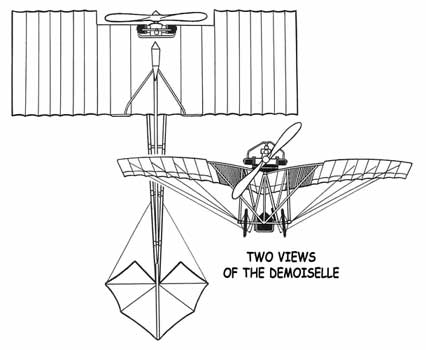
By this time, Santos had seen several Blériot aircraft in flight and had decided to construct a monoplane. The result was the Demoiselle No. 19, an ultra-light tractor monoplane made of bamboo and silk and weighing only about 153 pounds. The Demoiselle (nicknamed the Grasshopper) became a sensation all over Europe and was sold by the thousands, introducing an entirely new generation to the thrill of flight for less than five hundred francs. Many designers regarded the Demoiselle as an oddity, but the aircraft had a clear impact on many designers and its image can be seen lurking in the lines of Anthony Fokker's first aircraft, the Spinne (Spider) of 1912 and in light aircraft of the post war period.
In 1910, Santos-Dumont was diagnosed with multiple sclerosis. He went into retirement, though he followed aviation developments throughout the war. In 1928, he returned to Brazil and was given a hero's welcome. As his ship was docking, a sea plane carrying six prominent Brazilians who wished to greet him crashed and all six were lost. Santos, by this time quite frail, asked that all ceremonies and events honoring him be cancelled. On July 23, 1932, Alberto Santos-Dumont committed suicide. In his final years, he had become despondent about the destructive uses to which nations had put aviation, and about his role as a pioneer of flight.
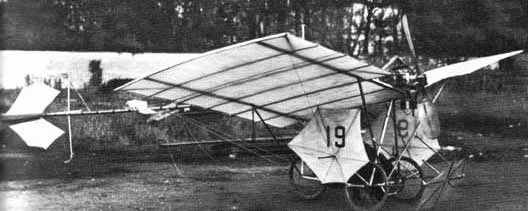 Another version of the Santos Dumont Demoiselle |
In 1910, Santos-Dumont was diagnosed with multiple sclerosis.
He went into retirement, though he followed aviation developments
throughout the war. In 1928, he returned to Brazil and was given
a hero's welcome. As his ship was docking, a sea plane carrying
six prominent Brazilians who wished to greet him crashed and all
six were lost. Santos, by this time quite frail, asked that all
ceremonies and events honoring him be cancelled. On July 23,
1932, Alberto Santos-Dumont committed suicide. In his final years,
he had become despondent about the destructive uses to which nations
had put aviation, and about his role as a pioneer of flight.
|
|
Specifications for the Alberto Santos-Dumont (No. 20) Demoiselle
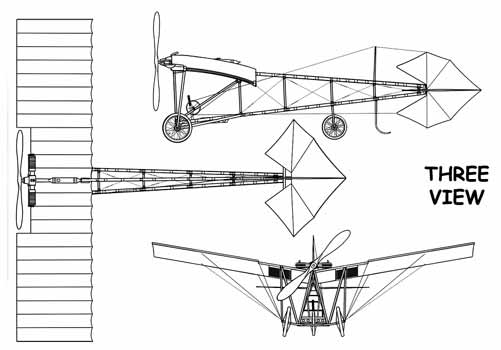 |
Length: 26 ft 3 in Wingspan: 16 ft 10 in Height: 7 ft 11 in Wing area: 110 ft² Gross weight: 314 lb Powerplant: 1 × Darracq, 35 hp Performance Maximum speed: 60 mph |




